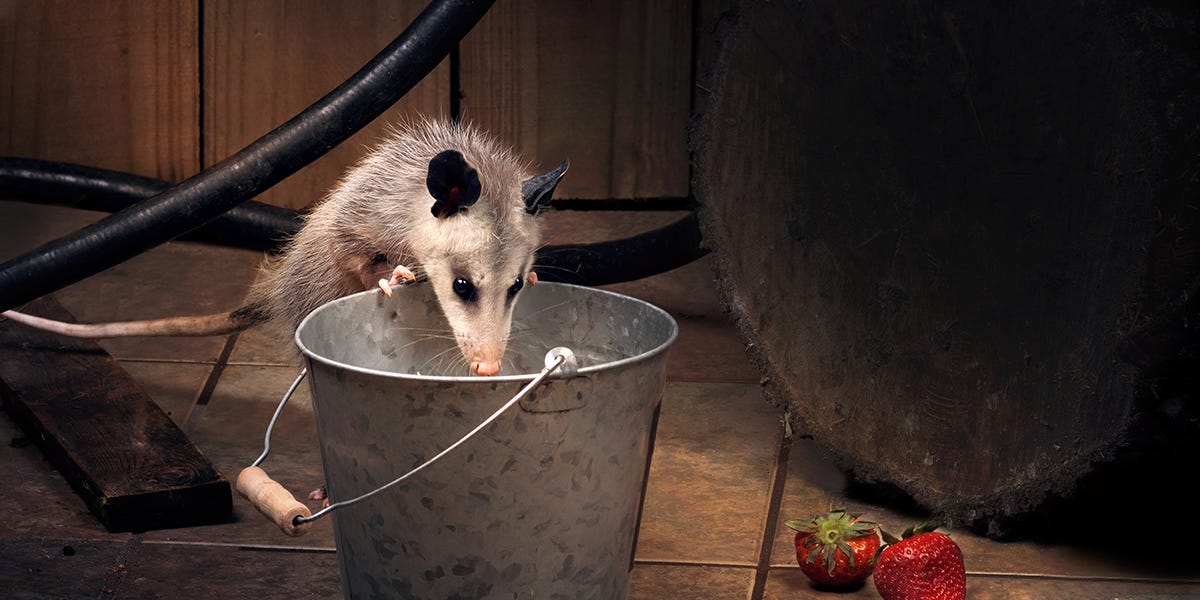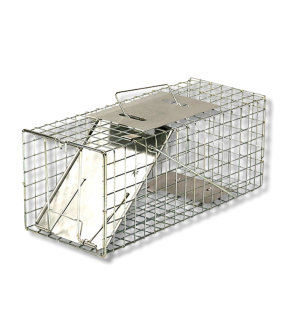Gain access to personalized product screening, the best pricing, rewards, and more!
Most Effective Products
How to Get Rid of Opossums in the Attic
Possums are intimidating at any time, but it can be a nightmare for homeowners to enter their attic and find one inside. These pests are usually found digging through your trash, but they may find an entry point to your attic. An opossum will not only disturb your sleep at night and leave droppings in your attic, but they can also cause damage to the insulation in your attic. One pest control method is using a live trap to capture and remove the animal. Live trapping is a safe and effective way to keep animals away from your home.
If you want to know how to eliminate possums in the attic, follow our DIY guide for product recommendations and instructions.
Identification
Before using a live trap, you must ensure that the wild animal in your attic is a possum. This will ensure that you are using the correct bait and strategies.

Possums are generally 20 to 36 inches long. They have gray fur, a white face, and a long, hairless tail. They normally weigh between 4 and 15 pounds and are intelligent animals. An opossum will "play dead" when they are threatened. The animal will look - and even smell - like they are dead. They will not move, their mouths will be open, and their anal glands will secrete an odor. This defense mechanism should last between a few minutes and a few hours.
An opossum is a scavenger that mainly feeds on carcasses and plants, but it is adaptable and will also consume small animals, insects, and sweet foods. Take caution when approaching or handling this animal. They are great climbers and can swim.
Use the image and description above to confirm that you are dealing with an opossum on your property.
Inspection
Once you have confirmed that your pest animal is an opossum, it is helpful to recognize the areas in the attic where it is most active. With these locations in mind, you will want to place your traps in the attic.
Where to Inspect
Possums are most likely in your attic, looking for shelter. If you have any clutter or storage bins in your attic, they are most likely near these particular spots. Search the corners and crevices of the attic as well. You will want to inspect any insulation for signs of activity.
What to Look For
Because possums are mostly nocturnal animals, the damage will mainly be done at night. One of the most obvious signs of a possum infestation is their droppings. These droppings are large with slightly pointed ends and resemble dog droppings. You will also want to look for damaged insulation.
Treatment
Now that you have identified your pest animal as an opossum and noted areas where it is most active, you can use your live trap. Be sure to wear gloves when handling the trap to prevent leaving your scent. If a possum picks up a human scent on the trap, it will avoid it, making it ineffective.
Step 1: Remove Food Sources

You want the opossum to enter the live trap with the help of bait. You also want to ensure they do not leave the attic and enter your home. Because of this, competing food sources need to be removed. Keep your trash sealed in trash bags and stored in trash bins. Other food sources, such as pet food, should be stored inside.
Step 2: Place the Trap
By now, you should have noted areas with high possum activity. These are where you will put your trap. Be sure to place your trap on an even surface. An opossum might push or knock over the trap to reach the bait inside. Place a brick or weight on top of the trap to avoid this.
Step 3: Bait and Set the Trap

Using the proper bait will increase your chances of catching a possum. These animals prefer sweet foods such as honey buns. The bait should be placed near the back of the trap. This ensures the opossum must step on the trigger plate to reach the food.
You will then set your trap by pushing on the door lock and lifting the door plate. Keep the door plate lifted while pulling the trigger arm forward to set it. You will know it is set when the trigger arm's hook catches the door.
Step 4: Monitor the Trap

You will need to check the traps twice a day, preferably once in the morning and once in the evening. This is when you will refill bait if needed. Checking the trap frequently may dissuade possums from approaching the trap. Do not keep an animal trapped in the cage for 24 hours.
Step 5: Relocate the Opossum
Any non-target animals should be released immediately. Once you have captured a possum in your live trap, check with your local authorities to ensure you correctly relocate the animal. Approach the trap slowly and use a gentle voice. Place a towel over the cage to avoid frightening the possum. Once you have relocated far enough, carefully open the trap and release the animal. You can read more about releasing an animal from a live trap here.
Prevention
After using your live trap, you want to ensure that wild animals do not invade your property again. You can take some preventative measures to keep your area possum-free.
Sanitation
A cluttered attic will provide plenty of material for a possum to take shelter. Be sure to remove all clutter and debris from the attic. Any potential food or water sources, especially pet food, should be properly sealed in a container and stored indoors.
Exclusion
If your property has a chicken coop, consider installing fencing or keeping live traps near the coop. Possums will consume both chickens and their eggs.
To prevent possums from entering your home, be sure to repair any voids or openings around the home or structure, such as damaged fences, windows and doors, holes along walls, large vents, and roofing.
Be sure to trim tree branches back away from the edge of your roof. Opossums will often gain access to your attic through overgrown tree branches.
Key Takeaways
- Opossums are nocturnal animals with gray fur, a white face, and a long hairless tail. If an opening is large enough, they can climb your house and enter your attic. Possums can potentially destroy the insulation in your attic and leave behind droppings and an odor.
- Bait the live trap with a sweet treat, such as a honeybun with an open wrapper or half of a slightly mashed banana. Make sure the bait is placed behind the trap's trigger plate.
- Check the trap once in the morning and once in the evening. Once an opossum is caught, check with your local authorities to ensure you safely and correctly release it.
- Remove any potential food sources and trash, and seal any holes and voids to prevent possums from entering your attic again.







